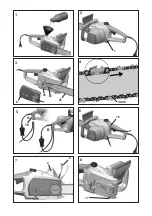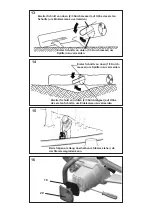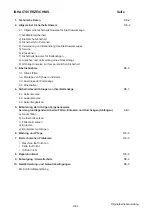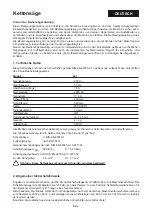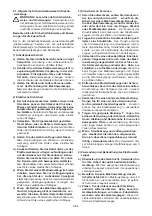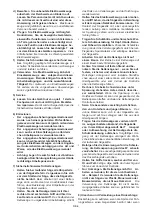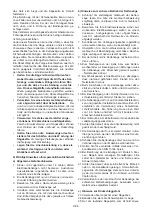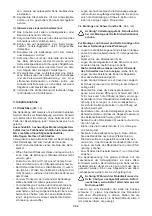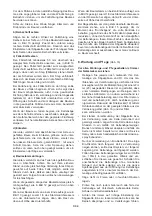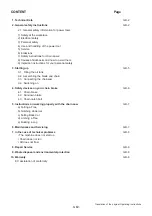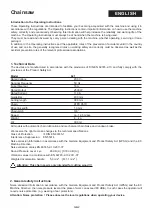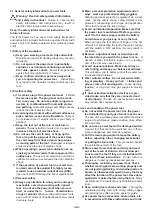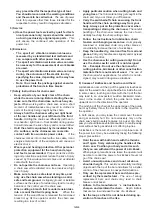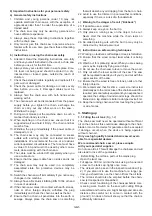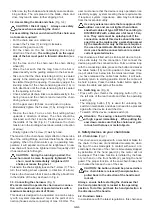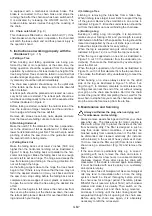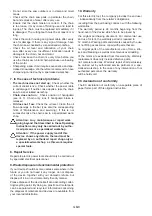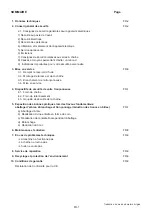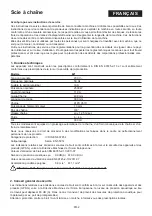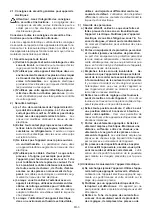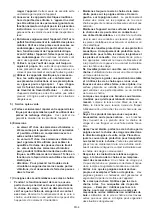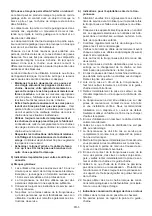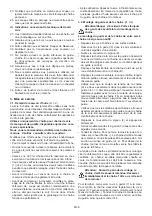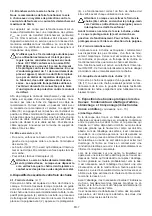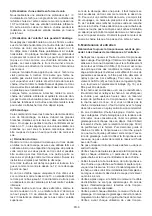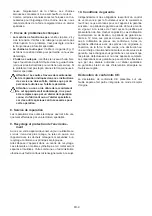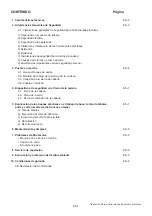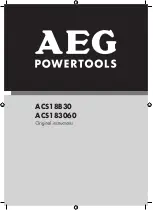
GB-3
2.1.General safety information for power tools
Warning! Read all safety-related information
and safety instructions!
Failure to observe the
safety information and instructions may result in
electric shock, burns and/or severe injury.
Keep the safety information and instructions for
future reference.
The term ‘power tool’ as used in the safety information
and instructions includes both mains-operated tools (with
power cord) and battery-operated tools (without power
cord).
1) Safety at the workplace
a) Keep your working area clean, tidy and well-lit.
Disorder and poorly lit working areas may result in
accidents.
b)
Do not operate the power tool in potentially
explosive environments containing combusti-
ble f uids, gases or dusts.
Power tools generate
sparks that may ignite dusts or fumes.
c)
Keep children and other persons away while
you are operating the power tool.
Distractions
may result in the operator loosing control over the
tool.
2) Electrical safety
a) The mains plug of the power tool must f t into
the mains socket. The plug must not be modi-
f ed in any way. Do not use adapter plugs/con-
nectors in combination with tools with protec-
tive earthing.
Unmodifi ed plugs and fi tting sockets
reduce the risk of electric shock.
b) Avoid physical contact with earthed surfaces as
pipes, heaters, ovens and refrigerators.
There is
an increased risk of electric shock if your body is
earthed.
c) Keep the tool out of the rain or moisture in
general.
The penetration of water into a power tool
increases the risk of electric shock.
d) Do not use the cord to carry or hang up the
tool or to pull the plug out of the socket. Keep
the cord away from heat, oil and sharp edges
or moving parts of the tool.
Damaged or tangled
cords increase the risk of electric shock.
e) When operating a power tool outdoors, use ex-
clusively extension cords that are approved for
outdoor-use.
The use of an extension cord that is
suitable for outdoor use reduces the risk of electric
shock.
f) If the operation of a power tool in a moist envi-
ronment cannot be avoided it is highly recom-
mended to use a residual current device (RCD).
The use of an RCD reduces the risk of electric shock.
3) Personal safety
a) Always pay attention to what you do and apply
reasonable care when working with a power
tool. Do not use the power tool when you are
tired or under the in f uence of medication,
drugs or alcohol.
When working with power tools,
even a short moment of inattentiveness may result
in severe injury.
b) Wear personal protection equipment and al-
ways wear eye protection (safety goggles).
Wearing personal protection equipment as a dust
mask, nonslip safety shoes, safety helmet or ear
protectors (depending on the type and application
of the tool) reduces the risk of injury.
c) Avoid unintentional operation. Make sure that
the power tool is switched off before you con-
nect it to the mains supply and/or the battery
and whenever you pick up or carry the tool.
When carrying the tool with your fi nger on the on/
off switch or connecting the tool to the mains supply
with the switch in ‘ON’ position, this may result in
accidents.
d) Remove adjustment tools or wrenches and
the like before you switch the power tool on.
A
wrench or other tool that is inside or on a rotating
part of the tool may cause injury.
e) Avoid unusual postures. Make sure to have a
safe footing and keep your balance at all times.
This will allow you to better control the power tool
in unexpected situations.
f) Wear suitable clothes. Do not wear wide cloth-
ing or jewellery . Keep your hair , clothes and
gloves clear of all moving parts.
Loose clothing,
jewellery or long hair may get caught in moving
parts.
g) If dust extraction/collection devices are pro-
vided make sure that they are connected and
used properly.
The use of a dust extraction device
may reduce risks caused by dust.
4) Use and handling of the power tool
a) Do not overtax the power tool. Use the power
tool intended for your type of work in each case.
The use of the suitable power tool within the stated
range of performance makes working more effec-
tive and safer.
b) Do not use a power tool with a damaged switch.
A power tool that cannot be switched on or off any
more is dangerous and must be repaired.
c) Pull the mains plug and/or remove the battery
before adjusting a tool, changing accessories
or putting the tool aside.
This precaution avoids
the unintentional start of the tool.
d) Store power tools that are currently not used
out of the reach of children. Do not allow per-
sons to use the tool if they are not familiar with
the tool or these instructions.
Power tools are
dangerous if used by inexperienced persons.
e) Thoroughly maintain your power tool. Check
whether moving parts are working properly and
are not jamming/sticking, and whether parts are
broken or otherwise damaged in a way that may
affect the function of the power tool. Have dam-
aged parts repaired before using the tool.
Many
accidents are the result of poorly maintained power
tools.
f) Keep cutting tools sharp and clean.
Thoroughly
maintained cutting tools with sharp cutting edges
are jamming less often and are easier to guide.
g) Use power tools, accessories, add-on tools, etc.
in accordance with these instructions and in the
Содержание solo 621
Страница 1: ...469599_a I 01 2015 Elektro Kettens ge Original Betriebsanleitung 621...
Страница 2: ...D 2 621...
Страница 6: ...3 A B 16 7 8 1 2 1 4 3 mm 5 18 A B 6 15 9 1 7 2 4 8 17...
Страница 73: ...GR 3 2 1 1 a b c 2 a b c d e f 3 a b c d e f g 4 a...
Страница 74: ...GR 4 b c d e f g 5 a 6...
Страница 80: ......

